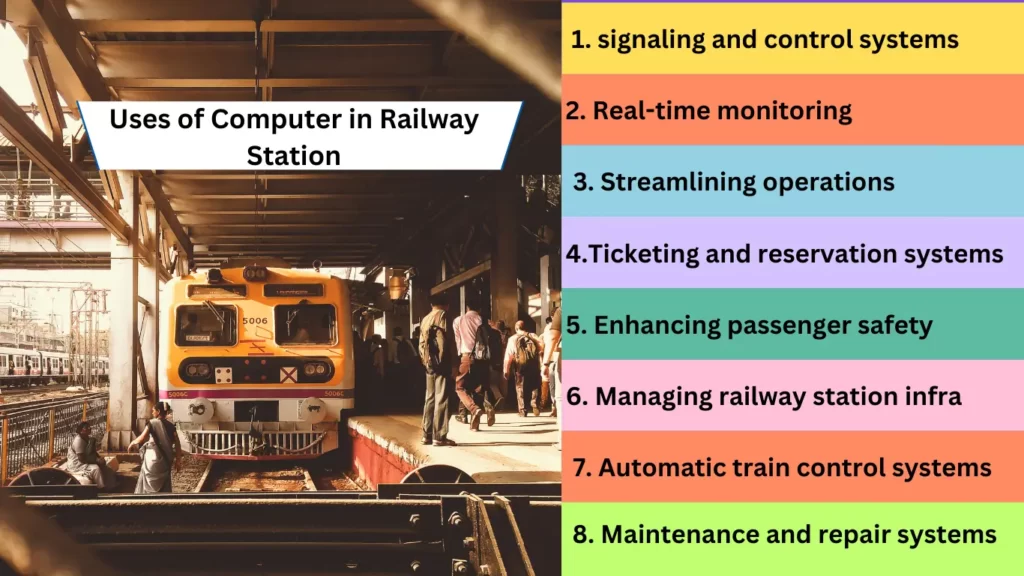Uses of Computer in Railway Station: Railway stations have come a long way from their humble beginnings. Thanks to the advent of computers, these bustling hubs of transportation have been completely revolutionized. This article explores the role of computers in railway stations, focusing on how they have transformed efficiency and safety measures.

TOP 8 Uses of Computer in Railway Station
1. Enhancing safety with computerized signaling and control systems
Automated signaling systems use sensors and algorithms to monitor the movement of trains and ensure safe distances between them. These systems can detect anomalies or potential collisions, immediately alerting the control room and taking necessary actions to prevent accidents.
Computerized signaling and control systems have become an integral part of modern railway stations, revolutionizing safety measures and ensuring smoother operations. As technology continues to advance, we can expect further enhancements in these systems, making railway travel an even safer and more efficient mode of transportation.
2. Real-time monitoring and predictive maintenance using computer technology
Maintenance plays a crucial role in ensuring the smooth running of railway stations. With the integration of computer technology, real-time monitoring and predictive maintenance systems have become invaluable tools for maintaining railway infrastructure and preventing potential breakdowns.
Real-time monitoring systems use sensors and data analytics to continuously monitor the condition of critical infrastructure components, such as tracks, signals, and switches. These systems can detect early signs of wear and tear, identify potential faults, and alert maintenance teams for immediate action. By addressing maintenance issues proactively, railway stations can avoid unexpected breakdowns and reduce the risk of service disruptions.
3. Streamlining operations with computerized scheduling and resource management
Computers have played a crucial role in streamlining these operations, optimizing the allocation of resources, and reducing delays. Efficient scheduling and resource management are essential for the smooth running of railway stations.
Computerized scheduling systems take into account various factors such as train capacity, passenger demand, and infrastructure availability to create efficient and reliable schedules. These systems can automatically adjust schedules in real time based on changing circumstances, such as delays or cancellations.
With the help of computerized systems, railway stations can efficiently manage the allocation of staff, platforms, and other resources. These systems consider factors such as staff availability, skill sets, and workload to ensure that resources are allocated optimally. This not only improves efficiency but also enhances the overall passenger experience.
4. Computerized ticketing and reservation systems
Computerized ticketing systems allow passengers to book tickets online, through mobile applications, or at self-service kiosks. These systems provide a convenient and hassle-free way for passengers to purchase tickets, eliminating the need for physical tickets and reducing paper waste. Passengers can simply present their electronic tickets or use their mobile devices to access the train.

Computerized ticketing and reservation systems have not only improved the overall customer experience but also enhanced the efficiency of ticketing operations in railway stations. With automated ticket validation and electronic ticketing, the process of boarding and ticket checking has become faster and more streamlined. This reduces queues and congestion at the station, ensuring a smoother flow of passengers.
5. Enhancing passenger safety with Computerized Signaling Systems
Computerized signaling systems use advanced sensors, algorithms, and communication networks to monitor the movement of trains and ensure safe operations. These systems detect anomalies or potential collisions, immediately alerting the control room and taking necessary actions to prevent accidents. By eliminating the risk of human error in signaling, computerized systems have greatly enhanced safety in railway stations.
Computerized signaling systems have become an integral part of modern railway stations, revolutionizing safety measures and ensuring smoother operations. With the integration of computer technology, we can expect further advancements in signaling systems, making railway travel an even safer and more reliable mode of transportation.
6. Managing railway station infrastructure with computerized maintenance systems
Computerized maintenance systems use sensors, data analytics, and predictive algorithms to monitor the condition of critical infrastructure components, such as tracks, signals, and switches. These systems can detect early signs of wear and tear, identify potential faults, and alert maintenance teams for immediate action.
Computerized maintenance systems also facilitate better asset management. By keeping track of maintenance activities, equipment performance, and lifecycle costs, these systems enable railway stations to make informed decisions regarding asset replacement, upgrades, and investments. This ensures that infrastructure remains in optimal condition, enhancing safety and reliability.
7. Automatic train control systems
These computerized systems use advanced technology to control train movements, minimizing the risk of accidents and improving overall operational performance. These systems can automatically control train speeds, maintain safe distances, and enforce operational rules. By eliminating the risk of human error, ATC systems enhance the safety and reliability of train services.
ATC systems have become an integral part of modern railway stations, revolutionizing safety measures and ensuring smoother operations. With the integration of computer technology, we can expect further advancements in ATC systems, making railway travel an even safer and more efficient mode of transportation.
8. Computerized maintenance and repair systems
Computerized maintenance and repair systems use data analytics, predictive algorithms, and automation to optimize maintenance processes. These systems can automatically generate maintenance schedules, allocate resources efficiently, and track the progress of maintenance activities. By streamlining maintenance operations, railway stations can improve efficiency, reduce downtime, and enhance the overall reliability of train services.
Computerized maintenance and repair systems have transformed maintenance operations in railway stations. By optimizing maintenance processes, improving asset management, and facilitating collaboration, these systems have significantly enhanced efficiency and reliability. Railway stations can deliver better services to passengers, ensuring a smooth and safe travel experience.
Conclusion: Uses of Computer in Railway Station
Computers have revolutionized the way railway stations operate, transforming efficiency and safety measures. From computerized signaling and control systems to real-time monitoring and predictive maintenance, computers have played a crucial role in enhancing safety and optimizing operations.
Computerized systems have minimized the risk of human error, ensuring safer train journeys. They have enabled better coordination between trains, improved resource allocation, and streamlined scheduling processes. Passengers can rely on more accurate and reliable schedules, making their journeys more convenient and predictable.

